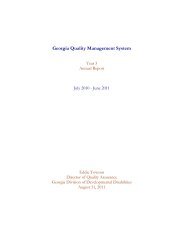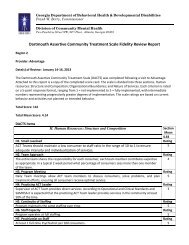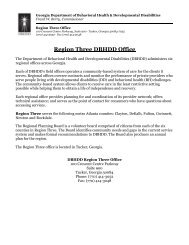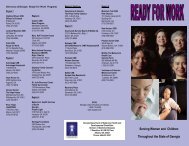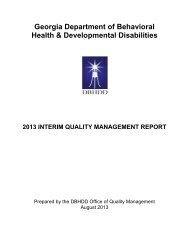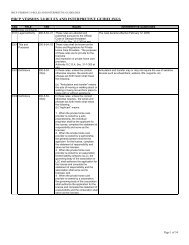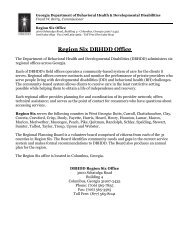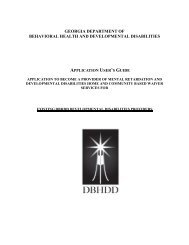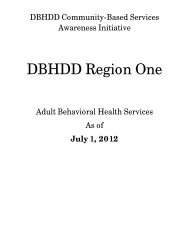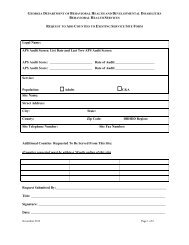PART I - Department of Behavioral Health and Developmental ...
PART I - Department of Behavioral Health and Developmental ...
PART I - Department of Behavioral Health and Developmental ...
You also want an ePaper? Increase the reach of your titles
YUMPU automatically turns print PDFs into web optimized ePapers that Google loves.
2. Policies, procedures, <strong>and</strong> guidelines for research promulgated by the DCH Institutional Review Board shallbe followed;3. The research design shall be approved <strong>and</strong> supervised by a physician;4. Information on the drugs used shall be maintained including:a. Drug dosage forms;b. Dosage range;c. Storage requirements;d. Adverse reactions; <strong>and</strong>e. Usage <strong>and</strong> contraindications.5. Pharmacological training about the drug(s) shall be provided to nurses who administer the medications; <strong>and</strong>6. Drugs utilized shall be properly labeled.iv. If research is conducted, there is evidence that involved individuals are:1. Fully aware <strong>of</strong> the risks <strong>and</strong> benefits <strong>of</strong> the research;2. Have documented their willingness to participate through full informed consent; <strong>and</strong>v. Can verbalize their wish to participate in the research. If the individual is unable to verbalize or otherwisecommunicate this information, there is evidence that a legal representative, guardian or guardian ad litem hasreceived this information <strong>and</strong> consented accordingly.g. Faith based organizationsi. Individuals or recipients <strong>of</strong> services are informed about the following issues relative to faith or denominationallybased organizations:1. Its religious character;2. The individual’s freedom not to engage in religious activities;3. The individual’s right to receive services from an alternative provider;a. The provider shall, within a reasonable time after the date <strong>of</strong> such objection, refer the individual toan alternative provider.ii. If the provider provides employment that is associated with religious criteria, the individual must be informed.iii. In no case may federal or state funds be used to support any inherently religious activities, such as but not limitedto religious instruction or proselytizing.iv. Providers may use space in their facilities to provide services, supports, <strong>and</strong> treatment without removing religiousart, icons, scriptures or other symbols.v. In all cases, rules found at 42 CFR Parts 54, 54a <strong>and</strong> 45 CFR Parts 96, 260 <strong>and</strong> 1050 Charitable Choice Provisions<strong>and</strong> Regulations: Final Rules shall apply.4. Service Environment: The Service Environment Demonstrates Respect for the Persons Served <strong>and</strong> is Appropriate tothe Services Provideda. Services are provided in an appropriate environment that is respectful <strong>of</strong> persons served. The environment is:i. Clean;ii. Age appropriate;iii. Accessible (individuals who need assistance with ambulation shall be provided bedrooms that have access to aground level exit to the outside or have access to exits with easily negotiable ramps or accessible lifts. The homeshall provide at least two (2) exits, remote from each other that are accessible to the individuals served).iv. Individual’s rooms are personalizedv. Adequately lighted, ventilated, <strong>and</strong> temperature controlled.b. Children seventeen <strong>and</strong> younger may not be served with adults unless the children are residing with their parents or legalguardians in residential programs such as the Ready for Work program.i. Emancipated minors <strong>and</strong> juveniles who are age 17 years may be served with adults when their life circumstancesdemonstrate they are more appropriately served in an adult environment.ii. Situations representing exceptions to this st<strong>and</strong>ard must have written documentation from the DBHDD RegionalOffice. Exceptions must demonstrate that it would be disruptive to the living configuration <strong>and</strong> relationships todisturb the ‘family’ make-up <strong>of</strong> those living together.c. There is sufficient space, equipment <strong>and</strong> privacy to accommodate:i. Accessibility;ii. Safety <strong>of</strong> persons served <strong>and</strong> their families or others;iii. Waiting;iv. Telephone use for incoming <strong>and</strong> outgoing calls that is accessible <strong>and</strong> maintained in working order for personsserved or supported; <strong>and</strong>v. Provision <strong>of</strong> identified services <strong>and</strong> supports.d. The environment is safe:FY2013 Provider Manual for Community <strong>Behavioral</strong> <strong>Health</strong> Providers



